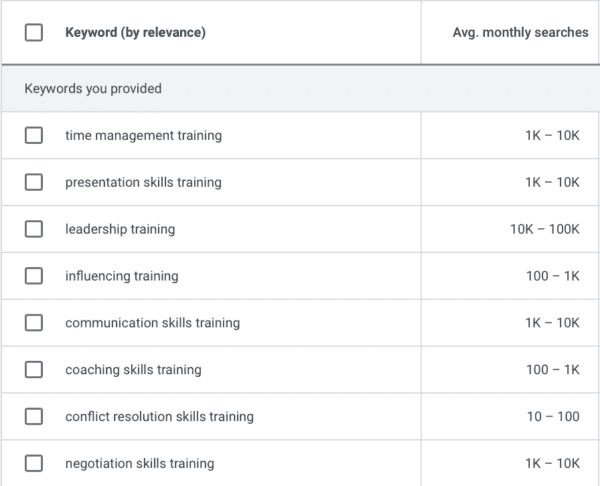You are Looking to Understand What is a Corporate Training Provider, How Effective They are, and Which Ones are the Best.
In this article, I’ll answer the most frequently asked questions about corporate training providers and corporate training companies.
What is a Training Provider? And a Corporate Training Provider?
A corporate training provider is a company that provides training for a company’s employees. Typically training programmes consist of training days where employees are trained in soft skills such as negotiation skills, or more technical skills (hard skills) like Prince 2 project management.
Also, read outsourcing training because we’ll answer all your questions on outsourcing training.
Which Company has the Best Training Program?
McDonald’s and Apple are the companies you may expect to provide the best training programs for their employees. After all, they want to attract the best employees. So, one way to do this is to have great development programmes that achieve two benefits; the employee gets better and in return, the company performance improves.
This article by Monster.com shows the top 10 companies with the best training and development programs. Those companies are; Seattle Genetics, SAS, Amazon, Bonobos, AT&T, Randstad US, Paychex, CyberCoders, Schneider Electric, and Marriott International.
How Many Training Providers are in the UK?

The UK has about 12,300 training providers, which has doubled since the year 2000. This report by IFLL (Learning and Work Institute) looks at the private and public training market in the UK. The report also highlights:
- The private training market in the UK is valued at £2.95 billion.
- Though the above figure is a small part of an employer’s total training expenditure as the majority is delivered internally.
- Only 1 per cent of training providers have over 250 employees.
Sticky Learning ® is 7 times more effective than 1-day training courses. Plus, you will get a Chain of Evidence proving your Return on Investment. Discover soft skills training that changes behaviours long term.

What is a Private Training Provider?
A training provider is a company which supplies the training. They typically design, deliver and evaluate the training. A public training provider delivers training like the government’s apprenticeship scheme or a Further Education College.
FE Week reported that ‘Private training providers will be patting themselves on the back this week, following Skills Funding Agency research that revealed they are significantly more popular with employers than general FE colleges.’
Also, read 7 important questions to ask your training provider.
How Effective are Corporate Training Programs?
They are not. The world has got used to and accepted that people attend training programs and then come back to their desks and do nothing differently. Furthermore, the evaluation of the training is just a ‘happy sheet’ on the day and both the company & the employee expect nothing more than to attend the training and to see no real difference. Yet they hope for better and this is changing with us.
The CIPD Learning and Skills at Work survey 2021 concluded on evaluations that:
Measuring the impact, transfer and engagement of L&D activities can’t simply be done by an end-of-course questionnaire or post-training survey. Instead, evidence needs to permeate and inform every step of the decision-making process.
Since last year, there has been a slight rise in the proportion of organisations (76% vs 70%) evaluating the impact of their L&D initiatives in some way. However, only a small minority are evaluating the wider impact on the business or society, or assessing the behaviour change of participants by measuring the transfer of learning into the workplace. Barriers to evaluation have intensified, particularly due to pressure from other business priorities, likely as a result of the disruption caused by the pandemic.
Also, read about Sticky Learning ® because we achieve real behavioural change and our 5-level evaluation because we provide you with what we call the chain of evidence at the end of each training course.
What are the Top 5 Training Courses that Employers Send Employees to?

This article from findcourses details the most popular courses. From the most poular diversity courses to IT courses.
According to Google’s Keyword Planner tool whcih shows the amount of times a word/phrase has been searched across the globe, the most popular soft skills course is leadership training:

Our most popular training courses are; Negotiation Skills, Presentation Skills, and Category Management.
Do Employers Train Employees?
Employers are more likely to train new employees via induction programmes and to train newly promoted employees, like line managers. They are less inclined to train current employees, although this thinking is changing slowly. Corporate training providers are typically the companies that train the employees in large companies.
The Association For Talent Development’s research concluded that in 2018 the average company’s direct learning expenditure represented 1.2 percent of revenue in 2018.
What are the Types of Corporate Training Programs?
A corporate training program should cover all the skills, behaviour and technical training needs of the employees to achieve the company’s targets. Typically the types of training is grouped as:
- Induction training is also known as Orientation training or Onboarding training.
- Technical training. For example excel skills for analysts or NEBOSH for the Health and Safety Officer.
- Soft skills training is those behavioural skills like negotiating, presenting, teamwork, and alike.
- Product training is about understanding the products and how they work best.
- Compliance training, which might be accountancy update exams for accountants.
- Franchise training for franchisees before they take over or set up a new franchise.
- Managerial and leadership training is really part of soft skills though so important it is often grouped separately.
How Do Companies Manage Training and Development Programs?

In large companies, the program is managed by a Learning and Development team (L&D Team) and in smaller companies normally the Director manages the program for his/her team, or the HR Manager manages the program.
A program is typically about having to encourage people to attend training courses and managing the drop-outs. In companies where the training program is managed better and delivered better by the training provider a learning culture is established where the following can be observed:
- The 70 20 10 model is followed whereby formal learning is not the only learning but it is a blended program. We call it Sticky Learning ®.
- Evaluations go far beyond the ‘happy sheet’ and training is evaluated on multiple levels adopting the Kirkpatrick 4 level of evaluation.
- Line managers support the learning of their teams by coaching them to embed the learnings.
What Does a Successful Training Program Look like?
There are 3 parts to a successful training program delivered by a corporate training provider.
- Employees want to attend and do the training because they know it improves their performance.
- For example, the Learner identifies their Individual Learning Objective (ILO) in the Learning to Learn training course because it solves a problem they have (Our LTL course is the first course any Learner does with us because it teaches them to how to learn. In essence, how to get the most from the time they’ll spend learning. ‘The most’ is behavioural change, because without changing behaviours the time was wasted.
- The training positively changes the behaviours of the employees.
- For example, the Learner attends a negotiation skills training course and completes a squaredance preparation template before each negotiation.
- Positive changes in employees’ behaviours positively affect the financial metrics of the company and can be measured in doing so.
- For example, the Learner can identify a number of negotiations where the preparation before negotiation led to a financial result that they would have otherwise not achieved. Maybe they won a tradeable that they might not have thought to have asked for.
How do I Find a Training Provider? Or Corporate Training Companies?
Look no further – You have! We are a corporate training provider. Check out our client testimonials.




